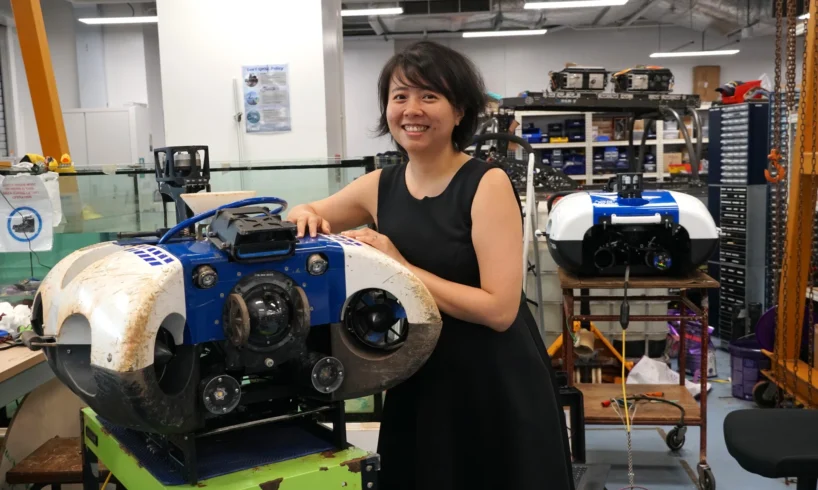
[SINGAPORE] Being a small fish in a big pond is paying off for BeeX, as the startup’s underwater drones prove cheaper and greener than their larger competitors.
The company designs, builds and operates submarine drones – also known as autonomous underwater vehicles (AUVs) – that provide maritime inspection services.
Named after the Malay term for anchovies, its A.Ikanbilis drone cuts the cost and time of underwater inspections by as much as 50 per cent and slashes emissions by up to 95 per cent compared to larger remotely-operated vehicles (ROVs).
The fundamental “innovation dilemma” with AUVs, said BeeX co-founder and CEO Grace Chia, is that they “disrupt the profits of the best-performing subsea companies”.
Large subsea companies “can charge their customers millions to use vessels with ROVs”, she said. With simpler AUVs, companies cannot charge such high rates – and thus do not have an incentive to develop them.
After the success of its first drone, BeeX is developing an AUV that is larger and therefore can perform a wider range of inspection jobs – while still retaining an edge over ROVs.
A NEWSLETTER FOR YOU
Friday, 8.30 am
SGSME
Get updates on Singapore’s SME community, along with profiles, news and tips.
Sea change
BeeX has its origins in Bumblebee, a National University of Singapore (NUS) autonomous robotics club that Chia started as a student in 2012. There, she met schoolmate Goh Eng Wei, who would later become the company’s co-founder and chief technical officer.
In 2013, Chia and Goh’s team won the Best New Entry award in RoboSub, an international student AUV competition in San Diego, US.
The next year, she graduated and started working for a Singapore-based company that specialised in conventional maritime inspections – where she realised the role that AUVs could play.
Maritime inspections involve examining structures that are on or under water, which can include oil rigs, offshore wind and solar farms, ship hulls, foundations or construction piles.
Chia realised that while AUVs cannot do repairs or additions, they can perform inspection jobs faster and cheaper than ROVs.
“ROVs can do anything and everything, but need a lot of resources,” said Chia. “You need to have big ships and well-trained personnel.”
ROVs are tethered to a mothership, where human pilots operate them. These motherships are purpose-built and tend to be large, as they need to provide piloting facilities, power and communications to the ROVs.
“If you want the cost of subsea inspection and data collection to drop, the only way is if you drop all these other things – but it goes against the business model of the conventional incumbents.”
That is where a startup could come in. Chia and Goh founded BeeX in 2018 with their own money and initial funding from the NUS Graduate Research Innovation Programme.
Bee agile
A.Ikanbilis, BeeX’s autonomous underwater drone, uses numerous sensors including sonar to map its environment in two and three dimensions in real time. PHOTO: DERRYN WONG, BT
In 2020, BeeX got a boost when it won first prize in Port Innovation Ecosystem Reimagined at Block71’s (Pier71) Smart Port Challenge for the application of AUVs to maritime inspections.
Pier71 is a joint startup incubator and accelerator by NUS Enterprise and the Maritime and Port Authority of Singapore.
The win helped the company gain exposure to maritime corporates and investors, said Chia.
“Being plugged into the ecosystem enabled us to explore new opportunities for growth. We gained attention from diving companies who were more open to using robots to support their work.”
After receiving Enterprise Singapore’s Startup SG Tech grant of S$500,000 in 2019, BeeX began developing A.Ikanbilis in 2020, with the drone’s first operations in 2023.
While ROVs can be as large as a minivan and weigh more than 3 tonnes, A.Ikanbilis is less than a metre long and weighs 70 kg. It has various sensors, including a camera, sonar, lasers and an electromagnetic probe that detects the thickness of materials.
Without the need for a tether or pilot, it can be launched from a wide range of smaller vessels or from the infrastructure it is inspecting.
A.Ikanbilis also reduces manpower costs. There is no need for a specialised mothership, and training a drone supervisor takes just six months, compared to five to seven years for an ROV pilot.
Furthermore, the drone can navigate more quickly than an ROV, as it uses sonar and other sensors to “see” beyond human sight. Unlike ROVs, A.Ikanbilis’s performance is not dependent on pilot skill.
“With real-time sensors, the drone knows exactly where it is at all times, while the computer calculates the exact path to take. On average, an AUV can be 50 per cent faster than human-controlled flight,” said Chia.
“Our ‘brain’ is more intelligent and tested across more locations compared to ROVs, and our system is a lot more scalable,” she added, referring to the drones’ autonomous navigation and surveying capabilities.
BeeX’s drones will get smarter as more data is gathered. “Our core advantage is that we have 14 years of underwater data to help our vehicles to learn.”
Sink to swim
The A.Ikanbilis drone inspecting a pile at sea. PHOTO: BEEX
BeeX has now grown to a team of 28 people. It last raised funds in a bridging round in 2023, with S$2 million from investors co-led by Earth Venture Capital and ShipsFocus Ventures.
“We’re currently in pre-Series A, so we are building the groundwork for scaling,” said Chia.
The company has served 20 clients so far this year, up from 11 in all of 2024, in locations ranging from Singapore, Malaysia and Taiwan to the Netherlands, Germany and the United Kingdom.
With its operating model established, BeeX will expand its fleet – doubling from four A.Ikanbilis drones to eight by year-end – and develop a bigger drone that can operate in more challenging environments.
Clients who adopted A.Ikanbilis are demanding more, said Chia. “Now they start to ask us: ‘Can your vehicle work for longer? Can it go deeper?’ So that gave birth to the second variant, Betta.”
Betta is 1.5 m long and weighs 300 kg – much heavier than A.Ikanbilis but still smaller than most ROVs. Scheduled to begin operations later this year, Betta can work longer and deal with harsher weather and higher currents than its predecessor.
Its development is supported by the Enterprise Singapore-Innovate UK grant, which was awarded in 2023 to a consortium formed by BeeX, offshore survey services contractor Sulmara and the University of Strathclyde.
Without Betta’s development costs, BeeX would be profit-making, said Chia.
But to go further in the AUV field, developing a more capable model was essential, she said. “I think it’s important to invest in development to ensure that the company has an up-sized chance of success in the long-term future.”
This is the second of a two-part series on maritime startups that have won awards in Port Innovation Ecosystem Reimagined at Block71’s (Pier71) SmartPort Challenge.
Pier71 is NUS Enterprise and the Maritime and Port Authority of Singapore’s joint startup incubator and accelerator programme.
Read the first part on CRecTech, a start-up that is bringing down the cost of green methanol for shipping, here.
CRecTech’s CEO Lim Kang Hui and CTO/COO Haw Kok Giap. PHOTO: DERRYN WONG, BT
Source





